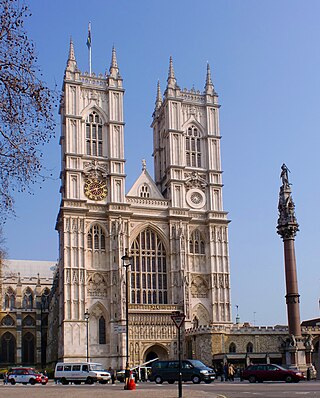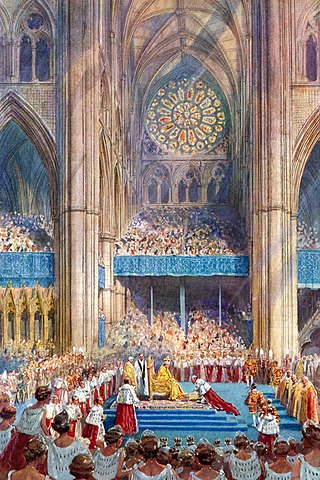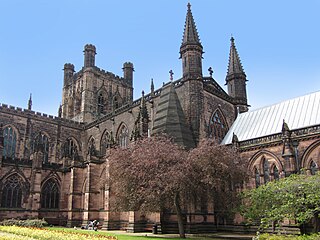
A carrel desk is a desk, often found in libraries, with partitions at back and sides to provide privacy. [1]

A carrel desk is a desk, often found in libraries, with partitions at back and sides to provide privacy. [1]
Carrel desks are especially common in academic libraries. [2] Sometimes the seat is integrated with the carrel desk. They may also have a shelf, built-in illumination, electrical outlets, or Ethernet ports. [1] Unlike the cubicle desk, carrel desks usually have no file drawers or other facilities. They are designed to stand alone or to be grouped together, with or without common sides or walls.
The word carrel may also refer to a small, isolated "study room" in public libraries and on university campuses; [1] the room may have a lockable door, to which the user is granted the key on request. Carrels typically contain a desk (not necessarily one described as above), shelving and a lamp. [1]
Carrels originated in monasteries to help contain the cacophony of roomfuls of monks reading aloud, as was the early practice. [3] Carrels are first recorded in the 13th century at Westminster Abbey, London, on the Garth side of the North Walk, though they probably existed from the late years of the 12th century. [4] [5]

An abbey is a type of monastery used by members of a religious order under the governance of an abbot or abbess. Abbeys provide a complex of buildings and land for religious activities, work, and housing of Christian monks and nuns.

The Palace of Westminster serves as the meeting place for both the House of Commons and the House of Lords, the two houses of the Parliament of the United Kingdom. Informally known as the Houses of Parliament, the Palace lies on the north bank of the River Thames in the City of Westminster, in central London, England.

Edward the Confessor was an Anglo-Saxon English king. Usually considered the last king of the House of Wessex, he ruled from 1042 until his death in 1066.

Westminster Abbey, formally titled the Collegiate Church of Saint Peter at Westminster, is an Anglican church in the City of Westminster, London, England. Since 1066, it has been the location of the coronations of 39 English and British monarchs, and a burial site for 18 English, Scottish and British monarchs. At least 16 royal weddings have occurred at the abbey since 1100.

William Shield was an English composer, violinist and violist. His music earned the respect of Haydn and Beethoven.

The Flores Historiarum is the name of two different Latin chronicles by medieval English historians that were created in the 13th century, associated originally with the Abbey of St Albans.

The coronation of the monarch of the United Kingdom is a ceremony in which they are formally invested with regalia and crowned at Westminster Abbey. It corresponds to the coronations that formerly took place in other European monarchies, all of which have abandoned coronations in favour of inauguration or enthronement ceremonies. A coronation is a symbolic formality and does not signify the official beginning of the monarch's reign; de jure and de facto their reign commences from the moment of the preceding monarch's death, maintaining the legal continuity of the monarchy.

The W. E. B. Du Bois Library is one of the three libraries of the University of Massachusetts Amherst, Amherst, Massachusetts, the others being the Science and Engineering Library, and the Wadsworth Library at the Mount Ida Campus. The W. E. B. Du Bois Library holds resources primarily in humanities and social and behavioral sciences. At 28 stories and 286 feet 4+1⁄8 inches tall, it is the third-tallest library in the world after the National Library of Indonesia in Jakarta at 414 feet and Shanghai Library in China at 348 feet. Measuring taller purely by height, the libraries in Jakarta and Shanghai both only have 24 floors. The W. E. B. Du Bois Library is also considered to be the tallest academic research library and 23rd tallest educational building in the world. The building is so large that it maintains a security force, which is managed by various supervisors and student employees.

The Henry VII Lady Chapel, now more often known just as the Henry VII Chapel, is a large Lady chapel at the far eastern end of Westminster Abbey, paid for by the will of King Henry VII. It is separated from the rest of the abbey by brass gates and a flight of stairs.

A chapter house or chapterhouse is a building or room that is part of a cathedral, monastery or collegiate church in which meetings are held. When attached to a cathedral, the cathedral chapter meets there. In monasteries, the whole community often met there daily for readings and to hear the abbot or senior monks talk. When attached to a collegiate church, the dean, prebendaries and canons of the college meet there. The rooms may also be used for other meetings of various sorts; in medieval times monarchs on tour in their territory would often take them over for their meetings and audiences. Synods, ecclesiastical courts and similar meetings often took place in chapter houses.

A sacristy, also known as a vestry or preparation room, is a room in Christian churches for the keeping of vestments and other church furnishings, sacred vessels, and parish records.

The Coronation Chair, known historically as St Edward's Chair or King Edward's Chair, is an ancient wooden chair on which British monarchs sit when they are invested with regalia and crowned at their coronations. It was commissioned in 1296 by King Edward I to contain the coronation stone of Scotland—known as the Stone of Destiny—which had been captured from the Scots who kept it at Scone Abbey. The chair was named after Edward the Confessor, and was previously kept in his shrine at Westminster Abbey.

Sainte-Geneviève Library is a public and university library located at 10, place du Panthéon, across the square from the Panthéon, in the 5th arrondissement of Paris. It is based on the collection of the Abbey of St Genevieve, which was founded in the 6th century by Clovis I, the King of the Franks. The collection of the library was saved from destruction during the French Revolution. A new reading room for the library, with an innovative iron frame supporting the roof, was built between 1838 and 1851 by architect Henri Labrouste. The library contains around 2 million documents, and currently is the principal inter-university library for the different branches of University of Paris, and is also open to the public.

Chester Cathedral is a Church of England cathedral and the mother church of the Diocese of Chester. It is located in the city of Chester, Cheshire, England. The cathedral, formerly the abbey church of a Benedictine monastery dedicated to Saint Werburgh, is dedicated to Christ and the Blessed Virgin Mary. Since 1541, it has been the seat of the Bishop of Chester.

Phillips Exeter Academy Library is a library that serves Phillips Exeter Academy, an independent boarding school located in Exeter, New Hampshire. It is the largest secondary school library in the world, containing 160,000 volumes over nine levels with a shelf capacity of 250,000 volumes.

The Grainger Engineering Library is a library at the University of Illinois at Urbana–Champaign College of Engineering for all disciplines of engineering at the University. It is situated on the north side of the Bardeen Quad on the engineering campus along Springfield Avenue. The Grainger Engineering Library is the largest library in the United States for the study of engineering. It is one of several "departmental" libraries that constitute the University of Illinois at Urbana–Champaign University Library.

English Gothic is an architectural style that flourished from the late 12th until the mid-17th century. The style was most prominently used in the construction of cathedrals and churches. Gothic architecture's defining features are pointed arches, rib vaults, buttresses, and extensive use of stained glass. Combined, these features allowed the creation of buildings of unprecedented height and grandeur, filled with light from large stained glass windows. Important examples include Westminster Abbey, Canterbury Cathedral and Salisbury Cathedral. The Gothic style endured in England much longer than in Continental Europe.

The Maughan Library is the main university research library of King's College London, forming part of the Strand Campus. A 19th-century neo-Gothic building located on Chancery Lane in the City of London, it was formerly the home to the headquarters of the Public Record Office, known as the "strong-box of the Empire", and was acquired by the university in 2001. Following a £35m renovation designed by Gaunt Francis Architects, the Maughan is the largest new university library in the United Kingdom since World War II.

The Stephen A. Schwarzman Building, commonly known as the Main Branch, 42nd Street Library or the New York Public Library, is the flagship building in the New York Public Library system in the Midtown Manhattan neighborhood of New York City. The branch, one of four research libraries in the library system, contains nine separate divisions. The structure contains four stories open to the public. The main entrance steps are at Fifth Avenue at its intersection with East 41st Street. As of 2015, the branch contains an estimated 2.5 million volumes in its stacks. The building was declared a National Historic Landmark, a National Register of Historic Places site, and a New York City designated landmark in the 1960s.

The Jesuit origins of Stonyhurst College in Lancashire, England, have enabled it to amass a large collection of books, a number of which concern recusant history, whilst artefacts from all over the world have been donated to the school by Jesuit missionaries and alumni. The school has four main libraries: the Arundell, the Bay, the Square and the More. It also has two museums: the Do Room and the Long Room.